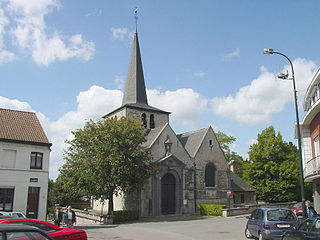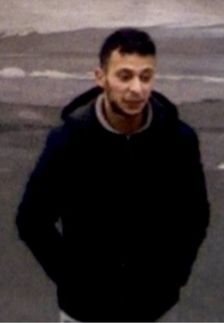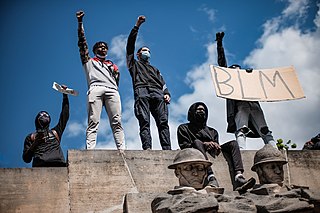
VRT 1 is a public Dutch-language TV station in Belgium, owned by the VRT, which also owns Ketnet, VRT Canvas and several radio stations. Although the channel is commercial-free, short sponsorship messages are broadcast in between some programmes.

Crime in Belgium is countered by the Belgian Police and other agencies.

Hans Van Themsche is a Belgian student who, on 11 May, 2006, shot three people, killing two and severely injuring another, before being shot by police and incapacitated. He was sentenced to life in prison in 2008.

Federal elections were held in Belgium on 10 June 2007. Voters went to the polls in order to elect new members for the Chamber of Representatives and Senate.
Guido Demoor (1952) was a Belgian NMBS/SNCB Thalys train driver and father of two children.
The Brussels Journal is a conservative blog, founded by the Flemish journalist Paul Beliën. It is consistently named as one of the counter-jihad movement's main channels. It was founded in 2005, and has both an English language section with various international contributions, and a Dutch section.
Bloed, Bodem, Eer en Trouw was a Flemish neo-Nazi group, created in 2004 from a splinter of the Flemish branch of the international Nazi skinhead organization Blood & Honour.

Haren is a former municipality of Brussels, Belgium, that was merged into the City of Brussels in 1921. It is an outlying part of the municipality and is situated at the north-eastern edge of the Brussels-Capital Region, bordering Machelen outside the boundary. Haren's postal code is 1130.
The 2007–2008 Belgian government formation followed the general election of 10 June 2007, and comprised a period of negotiation in which the Flemish parties Flemish Liberal Democratic, Christian Democratic and Flemish (CD&V) and New Flemish Alliance (N-VA), and the French-speaking parties Reformist Movement (MR), Democratic Front of Francophones (FDF) and Humanist Democratic Centre (CdH) negotiated to form a government coalition. The negotiations were characterized by the disagreement between the Dutch- and French-speaking parties about the need for and nature of a constitutional reform. According to some, this political conflict could have led to a partition of Belgium.
The Manga murder is a solved Belgian murder case once believed to involve a serial killer, referred to as the Manga Killer. The name of the case was coined by the Belgian media and has to do with the notes that were found near the victim. The notes carried a sentence in capital letters and in different colors, referring to the manga series Death Note: "Watashi wa Kira dess" [sic], a mis-transliteration of "I am Kira". Light Yagami, also known as Kira, is the protagonist and antihero of the series. The line is a reference to Kira from the Death Note series, who is a god-like figure who murders criminals by using a Shinigami's notebook called a Death Note. Light Yagami, who is Kira, speaks this line as a confession near the end of the series. In the series, Kira goes on a killing spree, assisted by his supernatural notebook, trying to cleanse the world of criminals and create a new world full of good people.

On 18 February 2013, eight masked gunmen in two cars with police markings stole approximately €38,000,000 worth of diamonds from a Swiss-bound Fokker 100 operated by Helvetic Airways on the apron at Brussels Airport, Belgium, just before 20:00 CET. The heist was accomplished without a single shot being fired.

The Jewish Museum of Belgium shooting was an antisemitic Islamist terrorist attack which took place in Brussels, Belgium, on 24 May 2014 when a gunman opened fire at the museum, killing four people. Three of them, an Israeli couple on holiday and a French woman, died at the scene. The fourth victim, a Belgian employee of the museum, later died of his injuries in hospital. Six days after the attack, on 30 May 2014, Mehdi Nemmouche, a 29-year-old French national of Algerian origin, was arrested during a routine drugs check in Marseille, France, when he was found to be carrying weapons identical to those used in the shooting. A second suspect, Nacer Bendrer, was later identified and arrested.

Salah Abdeslam is a Belgian-born Islamic terrorist who was sentenced to life in prison in France in 2022 as the only surviving member of the 10-man unit that carried out the attacks in Paris on 13 November 2015, in which 130 people were killed and more than 490 injured.

On 22 March 2016, two coordinated terrorist attacks in and close to Brussels, Belgium, were carried out by the Islamic State (IS). Two suicide bombers detonated bombs at Brussels Airport in Zaventem just outside Brussels, and one detonated a bomb on a train leaving Maelbeek/Maalbeek metro station in the city's European Quarter. Thirty-two people were killed and more than 300 were injured. Three perpetrators also died. A third airport attacker fled the scene without detonating his bomb, which was later found in a search of the airport. A second metro attacker also fled, taking his bomb with him. The Islamic State claimed responsibility for the attacks.

The Brussels Islamic State terror cell was a group involved in large-scale terrorist attacks in Paris in November 2015 and Brussels in March 2016. The terror cell was connected to the Islamic State (IS), a jihadist terrorist organisation primarily based in Syria and Iraq.

On 20 June 2017, a terrorist bomb caused a small explosion at Brussels-Central railway station in Brussels, Belgium; there were no casualties. Soldiers patrolling the station subsequently killed the suspect with three to four shots, according to eyewitnesses. The perpetrator was Oussama Zariouh, a 36-year-old Moroccan national who lived in the Molenbeek municipality and who had assembled a defective explosive device.
In Belgian football, the Operation Zero investigation, known informally as Operation Clean Hands, was conducted by the examining magistrate of Limburg on behalf of the Belgian Federal Public Prosecutor's Office from 2017 to 2019. The investigation was concerned with organized crime, money laundering, and private corruption (bribery) in Belgian football, division 1A and Division 1B specifically.
Renaud Hardy, known as The Parkinson's Murderer, is a Belgian serial killer who was sentenced to life imprisonment for murder, rape and attempted murder in 2018.

Shortly after protests seeking justice for George Floyd, an African-American who was murdered during a police arrest, began in the United States, some people in Belgium protested to show solidarity with Americans protestors and to demonstrate against issues with police or racism. Vigils and protests of up to thousands of participants took place nationwide.

The following is a timeline of the history of Brussels, Belgium, in the 21st century.













